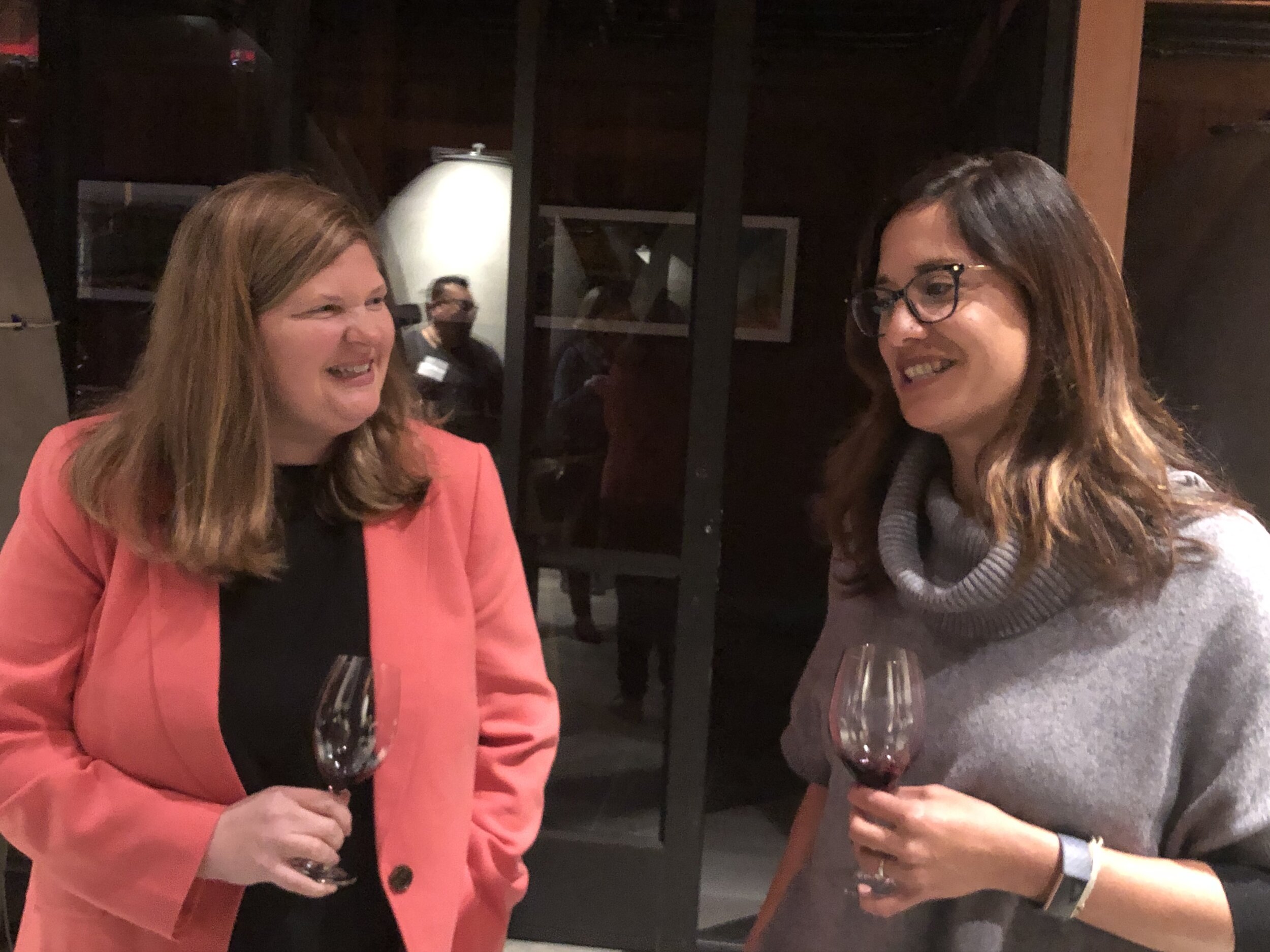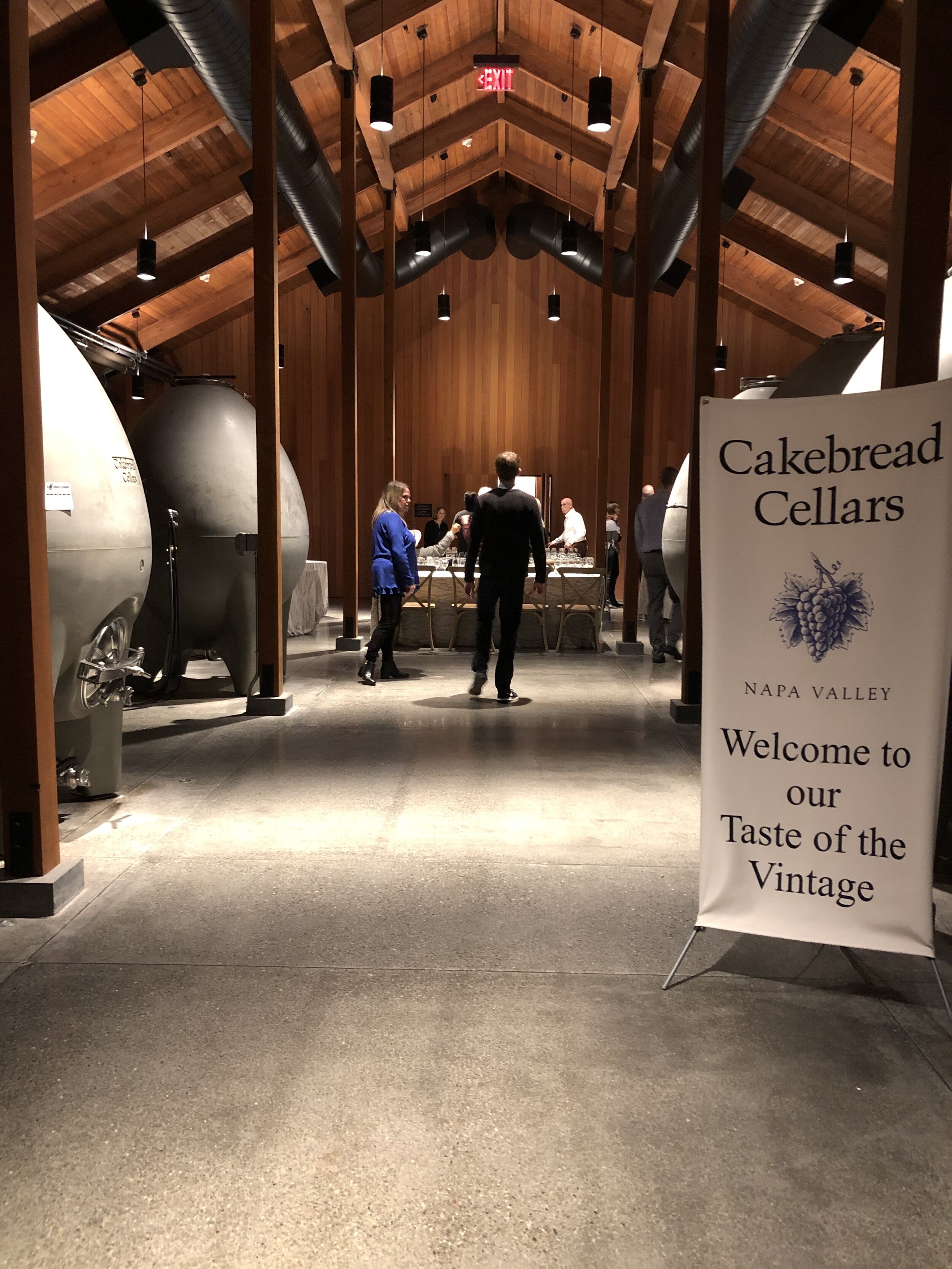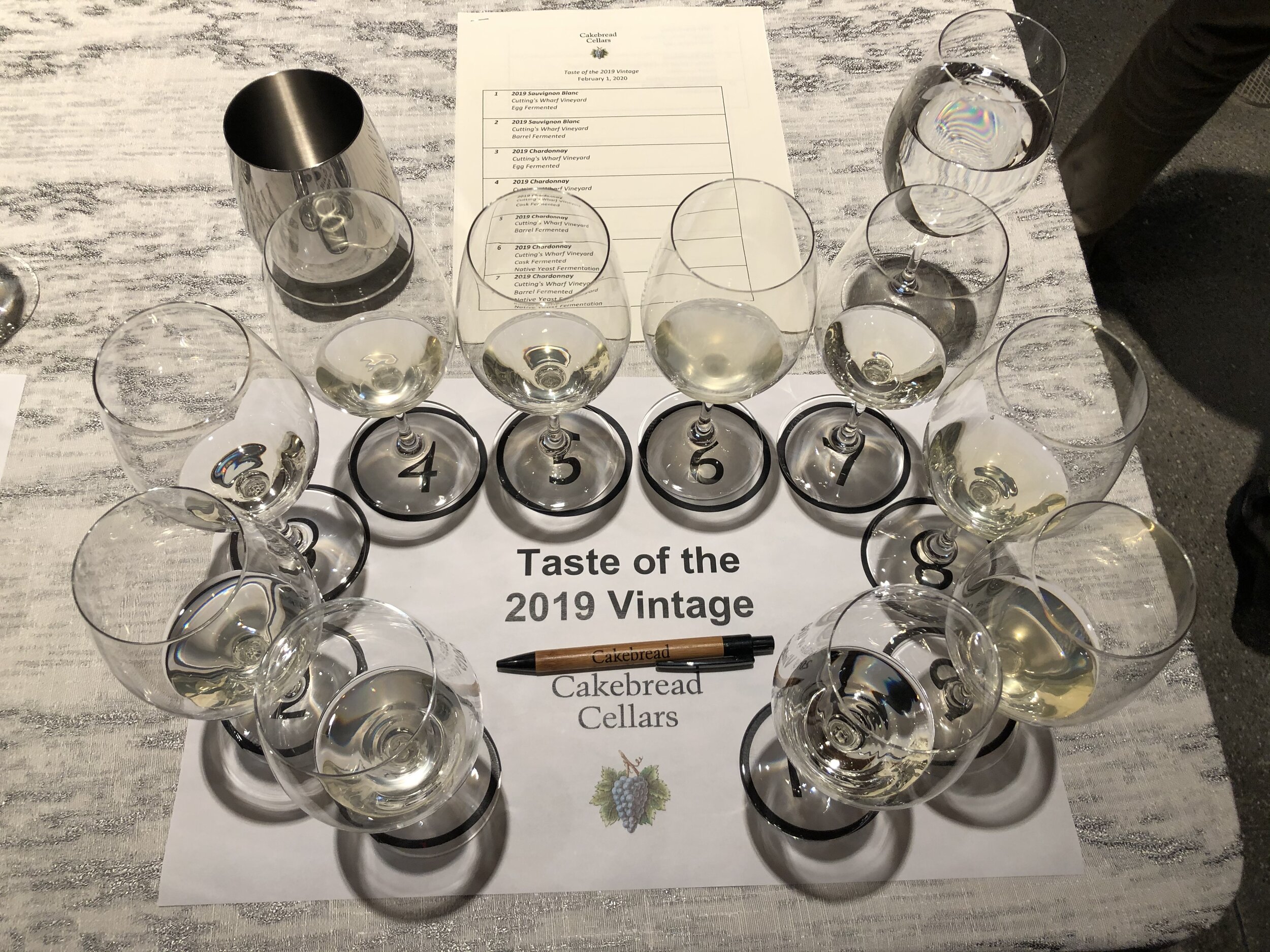The Legacy of Jack Cakebread
From a behind a gorgeous bouquet of roses, artichokes, lemons and mustard in a soaring redwood hall at Cakebread Cellars, Winemaker Stephanie Jacobs, Viticulturist Lise Asimont and Director of National Sales and Marketing Katie Griesbeck presented Cakebread’s 2019 vintage to the public for the first time. The event is called “Taste of the Vintage” and takes place every January. Griesbeck moderated a discussion where Jacobs and Asimont took turns describing the vintage, along with their philosophies about winemaking and wine growing.
The hall was newly built and part of Cakebread’s recent expansion. Some employees call it the “nest” because in it there are 12 concrete eggs used to ferment Cakebread’s chardonnay and sauvignon blanc. The eggs, cast in Sonoma and imprinted with the winery’s name, were lit from the bottom and top, casting circular shadows, as if they were hatching something mysterious.
Indeed they were. The flight was composed of 10 wines - two sauvignon blancs and eight chardonnays, all of which were grown in Cakebread’s Cuttings Wharf Vineyard in Carneros. For the participants, it was important to realize that these wines were not the finished product. What we had before us is what Jacobs may have in her lab when it’s time to blend the wines.
Of the 10, nine were fermented in a different way so that we could see what the different winemaking techniques produced. Some were cask fermented - and Jacobs pointed to an oak cask adjacent to the eggs in the “nest.” Some were barrel fermented, and others were fermented in the eggs. Jacobs also experimented with both native and industrial yeasts, which we tasted.
While the fruit element of the wines I found subdued, the aromatics were extraordinary. Honeysuckle and peach came to the nose, with hints of rosemary and thyme.
The tasting culminated in a finished product, the 2018 Chardonnay Reserve, whose fruit character - peaches, apricots - was on full display.
Winemaker Stephanie Jacobs has been at Cakebread for 16 years. She was promoted to winemaker from enologist when Julianne Laks, who had been at Cakebread since 1986, retired. Griesbeck asked Jacobs what has changed during that time. Jacobs said, “Our style hasn’t changed. We’ve always made fruit forward, food friendly wines. But how you get to that end product has changed, with all the advances in technology.” Jacobs said that there are machines in her lab that can now do in four hours, what it used to take 14.
Noting that Griesbeck, Jacobs and Asimont are all women, I asked Jacobs what it’s like to be on a winemaking team composed of women in an industry dominated by men. She looked at me blankly and was annoyed by my question. “I get that question a lot but the previous winemaker, Julianne Laks, was here for 32 years. Dolores Cakebread has always been at the helm of the company. At Cakebread, it’s always been the right person for the right job.” I suppose the gender discrimination that exists in so many other American industries does not exist in Napa Valley winemaking.
There is a natural comradery between Jacobs and viticulturist Lise Asimont. They recall fondly their time at UC Davis in the late 1990’s, hanging out in what was then a small department and cooking together. They both share a love of pinot noir and are more comfortable in muddy work boots than high heels.
While Asimont has only been at Cakebread for a year, she has been in the industry for 21 years and has worked on projects all over Europe in both viticulture and winemaking. When talking about Cakebread’s vineyards, she said, “it is a privilege and honor for me to work with these vineyards. Each one is so well designed. The perfect variety and the perfect root stock is paired with the perfect soil and the perfect microclimate.”
Asimont is a natural public speaker. She is bubbly and articulate. She effortlessly communicates her enthusiasm for what she does. In the year that she has been at Cakebread, she said her favorite thing so far was a soil study between the Dancing Bear Ranch Vineyard on Howell Mountain, and the recently acquired Suscol Springs Vineyard located in east of the Napa River, south of the Coombsville AVA, perched on a hill with a view of San Pablo Bay. She found that these two vineyards have the exact same soil type. But their microclimates are completely different as well as their proximity to water. She said, “as a viticulturist it is very exciting to get the opportunity to observe how, all other variables being the same, climate varies the character of the fruit. It was a very cool study for me.”
Asimont also likes the Suscol Springs Vineyard because it’s one of the most biodiverse places in Cakebread’s portfolio. Mountain lions are routinely sighted there and the vineyard is alive with insects, moles, voles and gophers. Though they are also home to a mating pair of Golden Eagles, who recently had a fledgling, and who hunt the moles, voles and gophers at every opportunity.
Suscol Spring’s brother in soil, the Dancing Bear Vineyard, is named for an actual bear. Dennis Cakebread noticed that every year there was a large amount of merlot that was removed from the vines. He could not figure out what was doing it. He set up some motion activated cameras and soon found they were tripped by a sleuth of bears. In one case, he saw a black bear actually scale the fence that protected the vineyard so he could get to the fruit. Since then, they affectionately refer to that vineyard as the one with the dancing bears.
Griesbeck told me Cakebread Cellars was founded, on a lark, by Jack and Dolores Cakebread in 1972. Jack had been working in his father’s garage in Oakland when Dolores signed him up for a photography workshop with Ansel Adams in Yosemite. He and Adams got on really well, so Adams introduced Cakebread to the publishers of a forthcoming book called “A Treasury of American Wine.” The publisher commissioned Cakebread to photograph the Napa Valley portion of the book. In doing that he met the Sturdivants who owned the 22 acre ranch on Highway 29. After a conversation, Cakebread told them if they ever wanted to sell, he was interested.
By the time he got back to Oakland, the Sturdivants had called ahead telling Dolores they were, in fact, willing to sell. Jack then used his $2500 photography commission as a down payment on the land where Cakebread Cellars now stands.
Jack and Dolores have three sons, Steve, Bruce and Dennis. Dennis and Bruce inherited the winery from their father and are current co-owners. They have recently brought in Mike Jeager as President and CEO who oversees the day to day operations.
After the tasting, we were ushered into a tank room - another soaring, vaulted redwood hall - where four tables were set for a three course lunch prepared by Chef Brian Streeter, who, like Julianne Laks, has been at the winery for the better part of three decades.
The first course was a vol-au-vent, which is a little round puff pastry tub filled with, in this case, delicate maitake mushrooms, salsify and spring garlic. A lid to the tub was perched off center just so, as if the mushrooms were trying to escape. It was served with Cakebread’s exceedingly rich 2013 Chardonnay Reserve, which was exceptional as most chardonnays can’t age three years.
The second course was a Liberty Farms duck breast, which must have been from a duck the size of a turkey. It was unctuous and gamey, and set over a endive choucroute - an alsatian technique that cooks down leafy vegetables, like in a sauerkraut, and is often served with a hearty meat. That was served with 2013 Napa Valley Merlot.
And, to finish, there was no sweet dessert for us. The cheese course consisted of Humboldt Fog chevre laced with truffles, Valley Ford’s gruyere-like “Highway One” and an exceedingly dry aged cheddar from the Vella Cheese Company. Also on the plate were marcona almonds, dried apricots, dates, quince jelly, a nut bread and a long narrow cracker, all of it composed as if it were an abstract painting. Cakebread’s 2012 Syrah complimented things perfectly.
At 3:00PM, I left the table a little fuzzy as one is want to be after a lunch like that. I walked into the graveled courtyard, passing a vegetable garden with beets and kale, and a fountain made from rusty wagon wheels, then inside the main reception center. On the wall were some of Jack Cakebread’s photos from the 1960’s. There was a portrait of Ansel Adams, bearded and smiling. But next to that was a picture of three boys, suspended in midair above a sand dune in the Mojave Desert, their father having told them all to jump at the same time. It was Bruce, Dennis and Steve, and their father Jack behind the camera, most likely, at that time, having no idea where they would be or what they would do, 60 years later, in 2020.
John Henry Martin went home and took a nap. Have you ever been to Cakebread? Where should he go next? Let him know at jhm@johnhenrymartin.com or go to www.johnhenrymartin.com.









